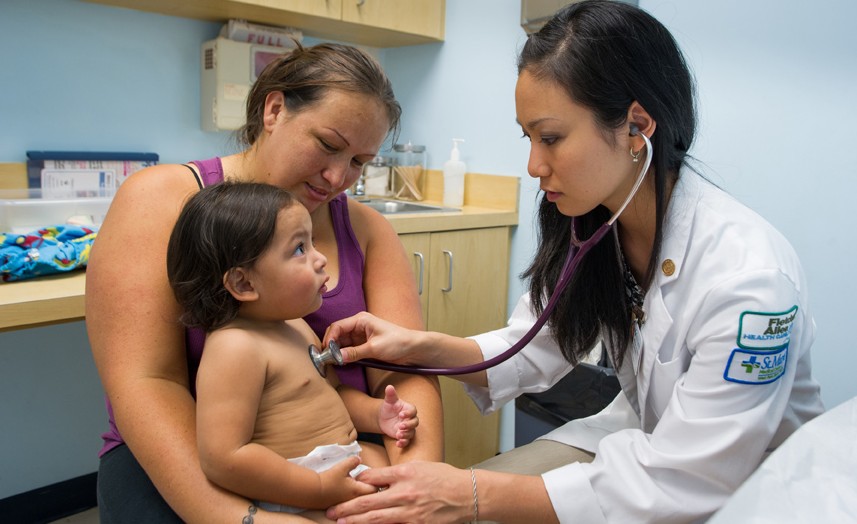What is the relationship between individual lifestyle factors and health inequalities and inequities?
If you ask health care providers, you’ll find a wide range of answers. But if you consider who is answering the question – and where they are coming from – you’ll understand the divergent viewpoints.
“This is what I teach my students: We can’t judge based on our position in society. That is biased. We need to care for patients without using our value system because that might not be the same from those we serve,” says Maria Mercedes Avila, Ph.D., assistant professor of pediatrics in the University of Vermont College of Medicine. She teaches “Racism and Health Disparities in the U.S.” as an adjunct faculty member in the College of Nursing and Health Sciences, and she has trained over 1,000 mental health clinicians, nurses, doctors and other providers in Vermont as part of grant-funded initiatives.
The Difference Between Inequality and Inequity
Any discussion of health inequalities and inequities needs to start with an understanding of the difference between the two, she explains.
“Equality has to do with sameness, giving everyone the same. This only works if everyone starts from the same place. Equity is about access to same opportunities, but we must first ensure equity before we can enjoy equality,”says Avila, who also is multi-cultural director of the Vermont Leadership Education in Neurodevelopmental Disabilities (LEND) Program and co-chair of the Association of University Centers on Disability (AUCD) National Multi-Cultural Council.
Lifestyle Factors and Social Determinants Leading to Health Disparities
When it comes to lifestyle factors, Avila does not dismiss the role of behavior in a person’s overall health. “We know that taking care of ourselves by eating well and staying active, not smoking, getting screening tests, etc. all influence our health,” she says. But there are other factors involved. “Our health,” Avila explains, “is also affected by access to social and economic opportunities.”
This interplay of “determinants of health” – which the U.S. Centers for Disease Control (CDC) defines as “factors that contribute to a person’s current state of health” – is complex. And the way in which a health care professional understands the link between individual lifestyle factors and social and economic factors, and how the professional emphasizes one determinant over another, can dramatically affect patients and their care.
“Lack of culturally responsive care has led to increasing health disparities and inequities in our society,” Avila explains. “We are all capable of bias and prejudice. What is important is first to be able to identify these biases and then put them in check. Otherwise the services and care provided will also be biased.”
Beyond recognizing this bias, it’s also important to act when we see it. “We all have a responsibility to intervene in an appropriate manner when biases are expressed by others and make clear statements that such bias and/or stereotyping is unacceptable,” she says.
The Impact of Bias and Prejudice on Health Care
At the beginning of her “Racism and Health Disparities” course, Avila asks students, many of them future health care providers, whether they believe they are biased or prejudiced toward any group.
“Very few students raise their hands,” she says. “But by mid-semester we do an activity to uncover these biases and prejudices. That is when they all realize they have biases, every one of them. Not being aware or able to recognize these biases will expose those we serve to substandard care.”
She tries to get students to “open their eyes” about racism and other forms of discrimination in American society. “Once you open your eyes, you will see these issues all around you. It has to do with privilege. For example, if you’re a white Caucasian in our society, you don’t have to worry about being stopped by the police, or being tailed in a store, or being treated as less intelligent by teachers, etc. These are the things that people are exposed to every day, their entire lives. And research shows that being exposed to these issues on a constant basis affects your health.”
For example, consider a patient’s lifestyle factors again. Depending on a health care provider’s background, he or she might blame a patient’s poor health on smoking, drinking lots of alcohol and a sedentary lifestyle.
But according to the CDC, these lifestyle factors, in and of themselves, do not determine a person’s overall health: “[I]n theory, genes, biology, and health behaviors together account for about 25 percent of population health.”
On the other hand, the “social determinants of health” – such as income, discrimination, access to quality health care, and safe and affordable housing – play a much larger role.
Yet it’s a complex dance; these social determinants of health “interact with and influence individual behaviors as well,” the CDC says.
The Importance of Addressing Social Determinants of Health
A major health initiative from the U.S. Office of Disease Prevention and Health Promotion, Healthy People 2020, highlights the importance of addressing the social determinants of health and to “create social and physical environments that promote good health for all” as one of the four overarching goals for the decade.
To address health disparities, the initiative suggests focusing on five key social determinants of health:
- Economic stability (poverty, employment, food security, housing stability)
- Education (high school graduation, enrollment in higher education, language and literacy, early childhood education and development)
- Social and community context (social cohesion, civic participation, perceptions of discrimination and equity, incarceration/institutionalization)
- Health and health care (access to health care, access to primary care, health literacy)
- Neighborhood and built environment (access to healthy foods, quality of housing, crime and violence, environmental conditions)
Collective History and Individual Behaviors
But Avila notes that you can’t just look at an individual’s present conditions. For each patient, there is an entire history – both individual and collective – to consider.
In class, she uses an example to explain the interplay of collective history and individual lifestyle factors.
“Some of the people with higher rates of substance use in our country are Native Americans,” she says. “But most of the time, my students don’t know about the Native American genocide, the suffering and political trauma these native groups have been exposed to. Eugenics and genetic research, boarding schools and reservations: the history of that trauma has been passed down through generations. Today, Native American youth have some of the highest suicide rates in the nation, but it’s not because they are inferior. The history of their suffering hasn’t been effectively addressed yet and the trust has not been restored.”
When you add this collective history to the present-day conditions on reservations – where some residents have no running water or little access to healthy food – that will “prevent people from having healthy lives no matter how much effort they put in,” Avila explains.
Overcoming Provider Bias
But there are still health care providers who blame patients, especially those who do not fit into the dominant culture, for their ill health.
The U.S. government recognizes the role of provider bias in health care. In its annual report on health disparities in America, the U.S. Agency for Healthcare and Research Quality, a division of the U.S. Department of Health and Human Services (HHS), notes that the “overall health of the American population has improved over the past few decades, but not all Americans have benefited equally from these improvements. Minority populations, in particular, continue to lag behind whites in a number of areas, including quality of care, access to care, timeliness, and outcomes. Other health care problems that disproportionately affect minorities include provider biases, poor provider-patient communication, and health literacy issues.”
To overcome provider bias, the HHS’ Office of Minority Health developed 15 federal mandates, the National Culturally and Linguistically Appropriate Services (CLAS) Standards. Among them:
- Providers must receive ongoing education and training in culturally and linguistically appropriate service delivery
- Organizations and providers have to conduct initial and ongoing self- assessments
- Organizations must recruit, retain, and promote at all levels of the organization a diverse staff and leadership
Yet in Avila’s trainings of over 1,000 Vermont health providers, “only a couple of people” had heard about the standards, she says. For her, that points to a need for even more training.
“It’s not that we’re asking people to be experts on every single culture and every single group,” she says. “It means that if we are working with, for example, the Somali Bantu, we need to move toward an integrative medical approach that considers their culture, beliefs, and history. We need more culturally responsive care and we need to diversify the health care workforce. Research shows that when a provider’s background and cultural beliefs mirror that of the patient the health outcomes are going to be better.”
Resources for Health Care Students and Providers
For more information about health, racial and socioeconomic disparities, Avila suggests watching the seven-part PBS documentary series, Unnatural Causes: Is Inequality Making Us Sick?. The series is available to UVM and the University of Vermont Medical Center affiliates online via the Bailey/Howe Library.
She also recommends these books:
- Abraham, Laurie K. (1993) Mama Might Be Better Off Dead: The Failure of Health Care in Urban America. The University of Chicago Press.
- Activism in America, 1890-1950. Philadelphia: University of Pennsylvania Press.
- Alexander, M. (2012). The New Jim Crow: Mass Incarceration in the Age of Colorblindness. The New Press.
- Bean, F. D., & Stevens, G. (2005). America’s Newcomers and the Dynamics of Diversity. Russell Sage Foundation.
- Bedolla, L. (2005). Fluid Borders: Latino Power, Identity, and Politics in Los Angeles. University of California Press.
- Cole, L. & Foster, S. (2000). From the Ground Up: Environmental Racism and the Rise of the Environmental Justice Movement. New York University Press.
- Fadiman, A.(1997). The Spirit Catches You and You Fall Down. New York: Farrar, Straus, and Giroux.
- Gallagher, N. L. (1999). Breeding Better Vermonters: the Eugenics Project in the Green Mountain State. Hanover, NH: University Press of New England.
- Graves, J. L. (2002). The Emperor’s New Clothes: Biological Theories of Race at the Millennium. New Brunswick: Rutgers University Press.
- Hammerschlag, C. (1989). The Dancing Healers: A Doctor’s Journey of Healing with Native Americans. Harper San Francisco.
- Hine, D. C. (1989). Black Women in White: Racial Conflict and Cooperation in the Nursing Profession, 1890-1950. Bloomington: Indiana University Press.
- Johnson, Allan G. (2006) Privilege, Power, and Difference. 2nd edition. McGraw-Hill, the McGraw-Hill Companies.
- Mahler, S. J. (1995). American Dreaming: Immigrant Life on the Margins. Princeton University Press.
- Martinez, R. (2002). Crossing Over: A Mexican Family on the Migrant Trail (Reprint.). Picador.
- Mills, Charles (1997) The Racial Contract. Cornell University.
- Nazario, S. (2007). Enrique’s Journey (later printing). Random House Trade Paperbacks.
- Pipher, M. (2003). The Middle of Everywhere: Helping Refugees Enter the American Community. Mariner Books.
- Reverby, Susan M. (2000) Tuskegee’s Truths: Rethinking the Tuskegee Syphilis Study. The University of North Carolina Press.
- Roberts, D. (2011). Fatal Invention: How Science, Politics, and Big Business Re-create Race in the Twenty-First Century. The New Press.
- Roberts, S.V. (2009). From Every End of This Earth: 13 Families and the New Lives They Made in America (1St Edition.). Harper.
- Roediger, David R. (1998) Black on White: Black Writers on What It Means to Be White. Schocken Books Inc.
- Rothenberg, Paula S. (2012) White Privilege: Essentials Readings on the Other Side of Racism. Worth Publishers.
- Skloot, Rebecca (2010) The Immortal Life of Henrietta Lacks. Broadway Paperbacks: Crown Publishing Group. Random House Inc.
- Smith, S (1995). Sick and Tired of Being Sick and Tired: Black Women’s Health.
- Tatum, B. D. (2003). Why Are All The Black Kids Sitting Together in the Cafeteria? (5th Anniversary, Revised.). Basic Books.
- Tichenor, D. J. (2002). Dividing Lines: The Politics of Immigration Control in America. Princeton University Press.
- Trafzer, C. (2001). Medicine Ways: Disease, Health, and Survival among Native Americans. Alta Mira Press.
- Wailoo, K. (2001). Dying in the City of the Blues: Sickle Cell Anemia and the Politics of Race and Health. Chapel Hill: The University of North Carolina Press.
- Wermuth, Laurie (2003) Global Inequality and Human Needs: Health and Illness in an Increasingly Unequal World. Pearson Education Inc.
- Williams, Patricia (1997) Seeing a Color-Blind Future: The Paradox of Race. Farrar, Straus, and Giroux.





